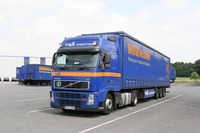Premium a better long-term investment than low-budget tyres
 German haulier, WLS Spedition, recently conducted a comparison of Premium tyres with low-cost Chinese-made products, in a bid to off-set rising fuel prices. For haulage companies, getting on top of the number one cost factor (the fuel consumption of their fleets) is all important. A truck’s fuel consumption is determined not only by the route, the engine and driving style but also by the tyres, or more precisely: their rolling resistance. The question asked by WLS Spedition was: Is it better to invest in resistance-optimised tyres, which may be more expensive to buy initially?
German haulier, WLS Spedition, recently conducted a comparison of Premium tyres with low-cost Chinese-made products, in a bid to off-set rising fuel prices. For haulage companies, getting on top of the number one cost factor (the fuel consumption of their fleets) is all important. A truck’s fuel consumption is determined not only by the route, the engine and driving style but also by the tyres, or more precisely: their rolling resistance. The question asked by WLS Spedition was: Is it better to invest in resistance-optimised tyres, which may be more expensive to buy initially?“We decided some time ago to fit our articulated vehicles with tyres from a low cost Chinese supplier”, explains WLS manager Thomas Leimkuhl. “The decisive factor was the low purchase price – a purely commercial decision which didn’t take into account the product’s technical features. While a premium trailer tyre would be priced at around €400, the equivalent from our Chinese supplier cost just €160. The price initially seemed to speak in favor of the cheaper option”.
Given the continuous rise in fuel prices, this spring the company had to decide definitively which tyres to use and test how much lower fuel consumption was with rolling-resistance-optimised tyres. WLS Spedition turned to a technically experienced workshop partner, with whom they developed a comparison test designed to produce the most objective results possible. This involved fitting an articulated vehicle entirely with the Chinese tyres and an equivalent vehicle with tyres from Continental. Both vehicles were then given the same load – roller shutters made of aluminum and accessories – with a total weight in each case of 25 tons, and put through a warm-up drive.
They then traveled an agreed route from Steinhagen to the Schüttdorfer Kreuz junction – a return journey of 208 kilometers, of which around 170km were on motorways and the remainder on ordinary roads.
General conditions
The vehicle running on Chinese tyres started first, with the other following. Cruise control ensured a largely uniform speed and prevented the drivers exceeding the 85 km/h limit. A flow-rate gauge monitored consumption during the journey. The trucks were manned by professionals who drove as fuel-efficiently as possible. Also on board were automated I-Shift transmissions, which likewise ensured a fuel-preserving trip.
On their return, mechanics swapped the tyres, from one vehicle to another, fitting each set in exactly the same position; then the trucks embarked on another identical trip – this time the vehicle with Conti tyres drove off first.
The result after 416 kilometers:
The resistance-optimized Conti tyre saved an average of 3% on diesel. When fitted with the premium tyres, the vehicles consumed an average of 29.3 litres of diesel for 100 kilometers, while the figure for those with the Chinese tyres was 30.4. This constituted an average difference of 1.1 litres.
While the difference may not initially sound dramatic, it rapidly adds up when applied to the entire WLS fleet, which comprises 100 articulated vehicles with an annual mileage of 120,000 kilometers each. Fitted with Chinese tyres, the WLS trucks would consume 132,000 litres more diesel a year and therefore, assuming a net diesel price of €1.09, cause additional costs of €143,880. Fuel prices at their current rate however mean that it would in fact be €158,400 more.
The additional consumption also has consequences for the environment; an extra 2.9 grams of CO2 were produced per kilometer. Given an annual mileage of 120,000 kilometers, this adds up to an extra 348 kilos per truck – with a fleet of 100 trucks, this translates into 34.8 tons of additional greenhouse gas emissions.
“Each haulage company has to apply the test for themselves. We adjusted the parameters precisely to our conditions of use”, argues Leimkuhl. WLS transports primarily high-volume but light loads. In many cases, the vehicle’s total weight does not exceed 25 tons. Driving with a total of 40 tons will potentially lead to even higher differences as every additional ton of load is connected to increased consumption.
The decision in favor of Premium
Thomas Leimkuhl believes the additional up-front costs for premium tyres rapidly pay off. He is therefore switching the fleet to Continental and accepts the higher acquisition price – again purely due to commercial considerations, the WLS boss stresses.
At the same time, however, Leimkuhl has not yet had the Chinese tyres removed. The next test is to see what mileage the Chinese imports are able to offer in order to include this factor in his calculations – something he had not previously done.
He also gives his drivers fuel-saving training sessions and uses tyre-pressure gauges in every vehicle to ensure that the air pressure is always right and fuel consumption is as low as possible. “Everything to remain competitive”, says Leimkuhl.

